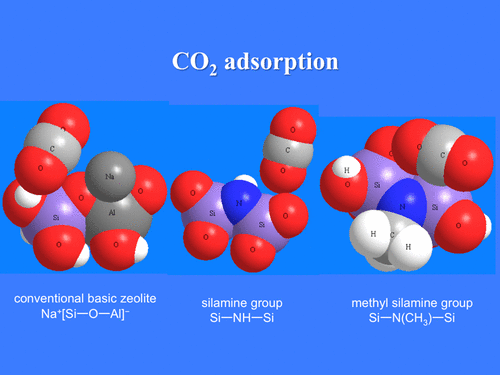Our official English website, www.x-mol.net, welcomes your feedback! (Note: you will need to create a separate account there.)
Identification of the Basic Sites on Nitrogen-Substituted Microporous and Mesoporous Silicate Frameworks Using CO2 as a Probe Molecule
Langmuir ( IF 3.9 ) Pub Date : 2018-01-17 00:00:00 , DOI: 10.1021/acs.langmuir.7b03769 Masaru Ogura 1, 2 , Shin-ya Fukuzawa 1 , Seiichiro Fukunaga 1 , Hiroshi Yamazaki 3 , Junko N. Kondo 3 , Masafumi Morimoto 4 , Remy Guillet-Nicolas 5 , Matthias Thommes 5
Langmuir ( IF 3.9 ) Pub Date : 2018-01-17 00:00:00 , DOI: 10.1021/acs.langmuir.7b03769 Masaru Ogura 1, 2 , Shin-ya Fukuzawa 1 , Seiichiro Fukunaga 1 , Hiroshi Yamazaki 3 , Junko N. Kondo 3 , Masafumi Morimoto 4 , Remy Guillet-Nicolas 5 , Matthias Thommes 5
Affiliation

|
Carbon dioxide was shown to identify surface basic properties of nitrogen-substituted microporous and mesoporous silicas, in addition to conventional basic oxides, by a detailed study using isotherm and heat of adsorption measurements as well as by infrared spectroscopy. A hydrogen-bonded weak interaction was primarily observed between CO2 and silanol (Si–OH) and silamine (Si–NH–Si) groups. The heat of adsorption of CO2 demonstrated that the latter adspecies were formed preferentially over the former, although a much higher amount of linear CO2 adspecies were found on SBA-15 mesoporous silica because of the presence of a large quantity of silanol groups on its surface. Carbamate-type chemisorbed adspecies were not detected on silamino sites, whereas carbonate-type adspecies were formed on alkali ion-exchanged zeolites and also residual sodium ions on the surface of silicalite-1. CO2 was shown to be a successful probe molecule for identifying weakly interactive hydrogen-bonding sites, and it has potential as a surface probe for strongly interactive nucleophilic sites derived from alkaline ions or a methylated silamino group, Si–N(CH3)–Si.
中文翻译:

使用CO 2作为探针分子的氮取代微孔和中孔硅酸盐骨架的基本位点的确定
通过使用等温线和吸附热测量以及红外光谱的详细研究表明,除常规的碱性氧化物外,二氧化碳还可以确定氮取代的微孔和中孔二氧化硅的表面碱性。主要观察到在CO 2与硅烷醇(Si–OH)和硅烷胺(Si–NH–Si)基团之间存在氢键键合的弱相互作用。吸附CO 2的热量表明,尽管后者的线性CO 2含量高得多,但后者的形成要优先于前者。由于SBA-15中孔二氧化硅表面存在大量硅烷醇基团,因此在SBA-15中孔二氧化硅中发现了相应的种类。在硅氨基位点未检测到氨基甲酸酯型化学吸附态,而在碱性离子交换的沸石上以及在silicalite-1表面残留的钠离子上形成了碳酸盐型态。事实证明,CO 2是识别弱相互作用氢键位点的成功探针分子,它有可能作为表面探针来探测源自碱性离子或甲基化硅氨基基团Si–N(CH 3)–的强相互作用亲核位点。硅。
更新日期:2018-01-17
中文翻译:

使用CO 2作为探针分子的氮取代微孔和中孔硅酸盐骨架的基本位点的确定
通过使用等温线和吸附热测量以及红外光谱的详细研究表明,除常规的碱性氧化物外,二氧化碳还可以确定氮取代的微孔和中孔二氧化硅的表面碱性。主要观察到在CO 2与硅烷醇(Si–OH)和硅烷胺(Si–NH–Si)基团之间存在氢键键合的弱相互作用。吸附CO 2的热量表明,尽管后者的线性CO 2含量高得多,但后者的形成要优先于前者。由于SBA-15中孔二氧化硅表面存在大量硅烷醇基团,因此在SBA-15中孔二氧化硅中发现了相应的种类。在硅氨基位点未检测到氨基甲酸酯型化学吸附态,而在碱性离子交换的沸石上以及在silicalite-1表面残留的钠离子上形成了碳酸盐型态。事实证明,CO 2是识别弱相互作用氢键位点的成功探针分子,它有可能作为表面探针来探测源自碱性离子或甲基化硅氨基基团Si–N(CH 3)–的强相互作用亲核位点。硅。



























 京公网安备 11010802027423号
京公网安备 11010802027423号